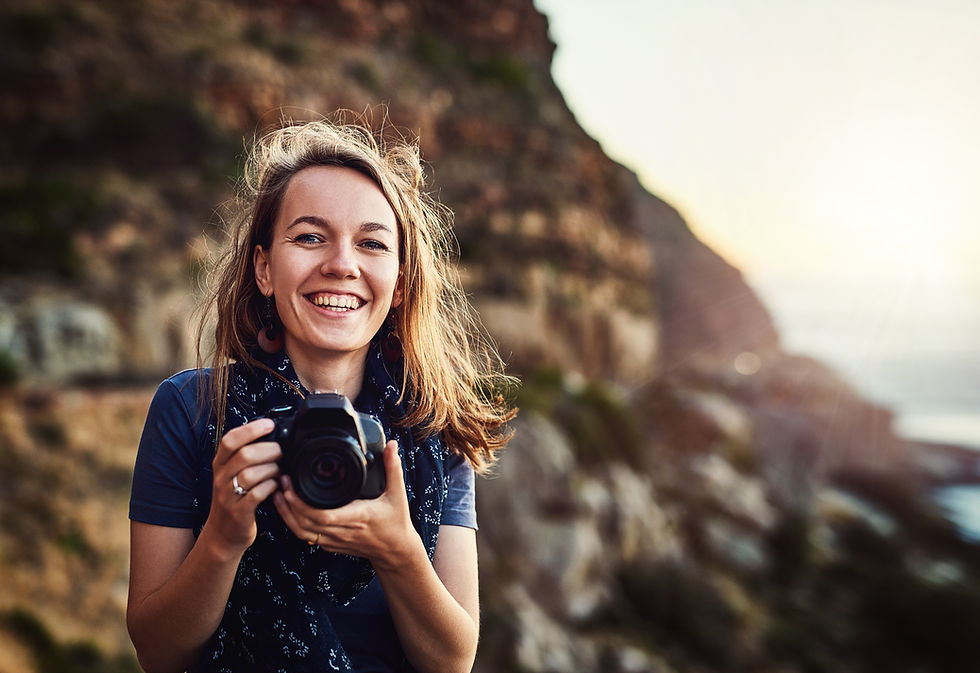10 Portrait Photography Tips Every Beginner Should Know
- Shawn Eastman
- Feb 14
- 4 min read
Updated: Feb 21

Portrait photography is an art that captures the essence of a person in a single frame. Whether you're just starting or looking to refine your skills, understanding key techniques can significantly improve your portraits.
Below, I'll share 10 essential portrait photography tips that every beginner should know.
Table of Contents
Master Your Camera Settings
To take great portraits, you need to understand your camera's settings.
Here are the most crucial ones to focus on:
Aperture: Use a wide aperture (low f-stop, such as f/1.8 to f/2.8) for a beautiful blurred background (bokeh effect), which helps the subject stand out.
Shutter Speed: Keep the shutter speed fast enough to avoid motion blur - typically around 1/200s for still portraits and faster if the subject is moving.
ISO: A lower ISO (100-400) ensures better image quality with minimal noise. Increase ISO only in low-light conditions.
Focus Mode: Use single-point autofocus (AF-S or One-Shot AF) for still portraits and continuous autofocus (AF-C or AI-Servo) for moving subjects.
Learning manual mode can be intimidating, but practicing with aperture priority (A/Av) or shutter priority (S/Tv) modes is a great way to transition.

Use Natural Light to Your Advantage
Lighting makes or breaks a portrait. Natural light is a beginner-friendly, cost-effective option - and after decades of shooting portraits, natural-light portraiture photography is still my favourite!
Consider these tips:
Golden Hour: Shoot during the golden hour (shortly after sunrise or before sunset) for soft, flattering light.
Shade Over Direct Sunlight: Harsh midday sunlight creates unflattering shadows. Move your subject into the shade or use a diffuser.
Window Light Indoors: Position your subject near a window for beautiful, soft lighting that mimics studio-quality results.
Reflectors: Use a white reflector or a piece of white foam board to bounce light back onto the subject’s face and reduce shadows.

Pay Attention to Backgrounds
A cluttered or distracting background can ruin a great portrait.
To keep the focus on your subject:
Choose simple, clean backgrounds or ones that complement the subject’s clothing.
Use a wide aperture (f/1.8 to f/4) to blur the background and create subject separation.
Experiment with different angles to minimize distractions behind the subject.
If the background is too busy, position your subject farther away to increase the blur effect.

Focus on the Eyes
The eyes are the soul of a portrait. If they're not sharp, the image can feel lifeless.
Here’s how to nail eye focus:
Use single-point autofocus and place the focus point directly on one of the subject’s eyes.
If the subject is slightly turned, focus on the eye closest to the camera.
In group portraits, use a slightly narrower aperture (f/4 to f/8) to keep multiple faces sharp.
Catchlights (reflections in the eyes) add life - position your subject near a light source to create them.

Guide Your Subject with Posing Tips
Many people feel awkward in front of a camera.
It’s your job to make them comfortable and pose naturally:
Avoid stiff poses: Encourage slight body angles instead of straight-on shots.
Hands matter: Avoid awkward hand placements - have them gently touch their face, lean on something, or hold an object.
Mind the posture: Ask the subject to relax their shoulders and keep a natural curve in their body.
Use movement: Small movements like a subtle head tilt, shifting weight, or walking create natural-looking portraits.
Encourage emotion: A genuine smile or thoughtful expression enhances the portrait. Engage in conversation to capture natural reactions.

Use Composition Techniques
A well-composed portrait feels balanced and visually appealing.
Use these techniques:
Rule of Thirds: Position your subject’s eyes along the top third of the frame for a natural composition.
Leading Lines: Use elements like roads, fences, or architectural features to direct the viewer’s eye to the subject.
Framing: Shoot through windows, doorways, or foliage to add depth.
Negative Space: Leaving space around the subject can add a creative, storytelling element.

Experiment with Different Lenses
Your choice of lens greatly impacts portrait quality:
50mm f/1.8 (Nifty Fifty): Affordable, sharp, and ideal for natural-looking portraits.
85mm f/1.8: Perfect for headshots with beautiful background separation.
35mm f/1.4: Great for environmental portraits where you want to include more background.
Zoom lenses (24-70mm or 70-200mm): Offer versatility, allowing you to adjust composition quickly.
Avoid ultra-wide lenses (below 24mm) for close-up portraits as they can cause distortion - unless you're purposefully looking to get really creative and different with the portrait.

Master White Balance for True-to-Life Colours
Auto white balance works most of the time, but for consistency:
Use Daylight for outdoor shoots in the sun.
Cloudy/Shade adds warmth on overcast days.
Tungsten corrects yellow indoor lighting.
Shoot in RAW to fine-tune white balance during editing.

Post-Processing to Enhance Portraits
Editing brings out the best in your portraits.
Essential post-processing tips:
Adjust exposure, contrast, and white balance for a polished look.
Retouch skin naturally using frequency separation or light blemish removal.
Enhance the eyes by increasing sharpness and slightly brightening them.
Use a vignette to subtly draw attention to the subject.
Don’t overdo it - avoid overly smooth skin or unnatural colours.
Use tools like Adobe Lightroom for photo editing and to streamline your workflow - YouTube is fantastic as a free resource for learning both basic and more advanced editing techniques with Lightroom or your photo editing software of choice.

Let the Practice Commence
The best way to improve is through constant practice.
Challenge yourself with:
Shooting in different lighting conditions.
Trying various locations and backgrounds.
Experimenting with new poses and expressions.
Learning from mistakes and refining techniques.

My Final Thoughts
Mastering portrait photography takes time, patience, and practice. By applying these tips and experimenting with different techniques, you'll develop your unique style and create stunning portraits. Now, grab your camera and start capturing beautiful moments!









































